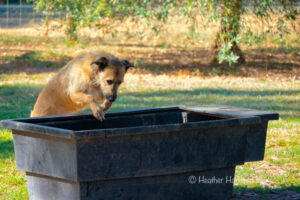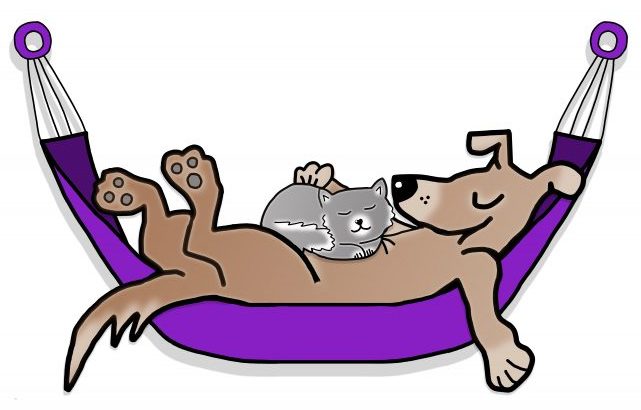Our kennel style offers an exciting and engaging environment for dogs, where they can have fun, burn off energy, and develop essential social skills while enjoying the company of a friendly pack. However, we believe in complete transparency regarding the potential risks associated with this approach. By understanding these factors, you can make the best choices for your beloved pet’s well-being and happiness.

Potential Injuries
We take pride in matching and monitoring play buddies for dogs (please refer to our Canine Info page). However, since dogs can be unpredictable, there will inevitably be times when playful interactions result in injuries among enthusiastic pups. This is simply a part of dog play.
Injuries can also occur during dog-to-dog corrections. While dogs’ body language and communication styles are similar, subtle differences can lead to misunderstandings. Injuries can happen when dogs are establishing their boundaries or when a playmate oversteps acceptable play etiquette.
Every dog is unique, and while they cannot ‘speak’, we can usually (but not always) interpret their thoughts through their body language. These observations guide us as we monitor their play.
The benefits of improved mental well-being, enhanced socialisation skills, and increased fitness levels outweigh the risks of injury (well, we like to think so). If you have significant concerns about these risks, we recommend considering a more traditional kennel for your pet.
Veterinary Costs
The owner is responsible for covering the cost of veterinary care if their dog is injured during friendly play. However, if we make a mistake in judgment—such as selecting an inappropriate playmate—that leads to an injury, we will discuss the situation with the owners to reach an appropriate arrangement.
We prioritise honesty, openness, and transparency when addressing any injury concerns with our valued customers. Suppose you disagree with our assessment of the situation. In that case, we ask that you provide written documentation from your veterinarian stating that, in their opinion, Nathalia Boarding Kennels & Cattery is responsible for your pet’s condition.
Below, we will explore some common issues related to these situations.

Eyes
One drawback of having fun and playing with new friends at NBKC is that sand, dust, or other debris may get lodged in a dog’s eye.
Additionally, due to the different environmental factors—such as the presence of various trees and pollen on our grounds compared to those at home—some dogs may also experience eye irritations from unseen particles in the air.
Foreign matter in the eye can lead to non-infectious conjunctivitis. Certain dog breeds, such as Cocker Spaniels, Bulldogs, and Miniature Schnauzers, are particularly prone to dry eyes, which can also result in non-infectious conjunctivitis.
The staff, known as the Purple People, closely monitor the dogs’ eyes and flush any suspicious-looking eyes with saline solution to remove any debris that may be trapped. However, it’s important to note that irritation can sometimes take a few days to become noticeable or uncomfortable, and symptoms may not manifest until you return home.
Further information can be read on our eye page.
| Types of Conjunctivitis | Symptoms |
| 1. Non-infectious Conjunctivitis 2. Bacterial Infection (rare) 3. Viral Infection (also rare) | ~Red or Puffy Eyes ~Eye Discharge ~Eyes Sticking together or squinting ~Swelling of the eyelid lining (the conjunctiva) ~Rubbing or pawing at the eye due to itchiness or discomfort |
| How do I know which type it is? | Only a vet test can accurately assess the type. |

Paws
We have had many discussions with our trusted veterinarians regarding paw pads. Most dogs have tough skin on their pads and can handle abrasive materials well, but a small percentage do not.
In our environment, this means that some dogs may struggle with river sand, which is spread as a base in some yards, or when running along the fence line while interacting with other dogs. This can lead to a gradual development of sore spots (similar to blisters) or cause the tougher outer skin to separate from the pad. If sand gets caught between the dog’s toes, it can be both painful and irritating.
Often, the buildup of friction on the pads means that symptoms may not become apparent until the dog is home. At that point, they may start to lick or “worry” at their pads in an attempt to find relief. Unfortunately, this behaviour can worsen the issue, so it’s necessary to intervene by either using a cone or applying a non-edible antiseptic spray. A visit to the vet is recommended for proper intervention.
Once we identify that a dog has sensitive pads, we will monitor their feet closely during future visits and adjust their yard settings and activity plans to help protect their pads from injury.
Additionally, insect bites from ants or bees can cause foot issues that exhibit similar symptoms.

Weight
Energy intake must equal energy expenditure, and we are constantly striving to find the right balance between the two, especially for active breeds.
We have several strategies to help achieve this balance, such as adjusting breakfast portions, conducting weigh-ins, incorporating coconut oil and eggs, providing extra high-energy snacks, and recalibrating rest times.
Striking the right balance involves careful consideration. While it’s essential to increase calorie intake, this must be done cautiously to avoid GDV (Gastric Dilation Volvulus) or bloat. Offering too much food too quickly can have disastrous consequences, while insufficient intake can lead to weight loss.
Many dogs can be too excited to eat breakfast, and new dogs may feel shy or uncertain about their surroundings. Some dogs can be naturally picky eaters, while others are not. Every dog is unique, and it may take time to determine the best approach for each individual.
In summary, we do our absolute best, but achieving the right balance can be pretty challenging at times.
If you are bringing food for your dog, please remember to increase the portion sizes accordingly. If you plan to leave your active dog for an extended period, you must include breakfast as part of their weight management plan.
If weight loss is a critical concern, we encourage you to seek boarding options that better suit your dog’s needs.
Ligaments/Joints
Torn or damaged ligaments can occur at any time and in any location, not just on our premises. While the likelihood is higher in our active environment, it is vital to understand and accept this risk. Please note that we do not cover medical expenses for ligament damage. If you are worried about your dog’s joint health, obtaining private pet insurance could be a wise financial decision.
Gastro Type Symptoms
Dogs can be curious and adventurous eaters, often sampling bizarre and unpleasant items they encounter in their environment. Our grounds are filled with enticing scents, including natural treasures like dog, bird, and possum droppings. While these may lead to a temporary upset stomach if ingested, we are equipped with effective nutritional solutions to alleviate any digestive discomfort during their stay.
It’s important to note that, just like in a preschool setting, there may be times when a gastro-type bug circulates among our furry guests. We prioritise your peace of mind and have well-defined processes in place to keep you informed about any such occurrences, both before and after your dog’s boarding experience.
Post-Board
You will receive a follow-up email to remind you of the issues mentioned above. We welcome your feedback. Your shared insight helps us strengthen our services and enhance our customer relations.
